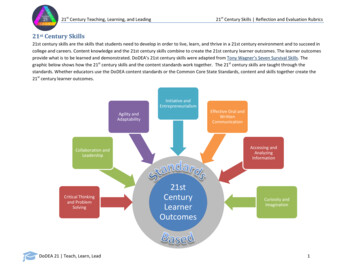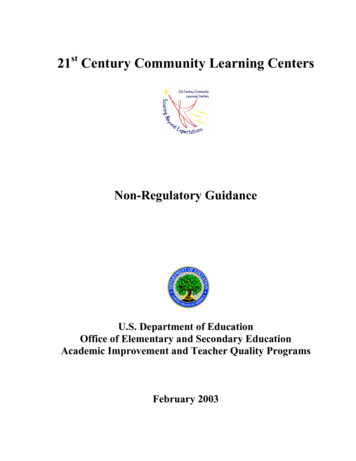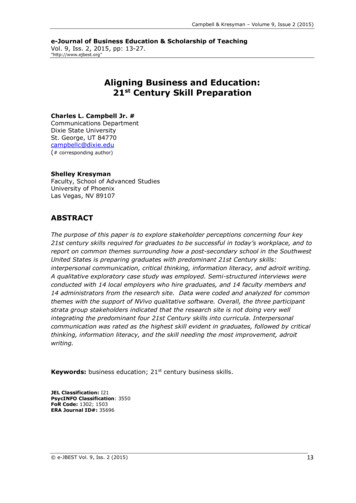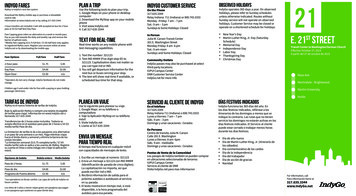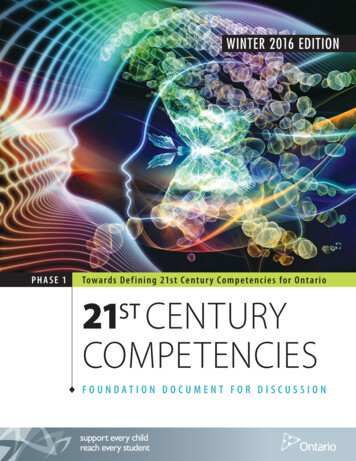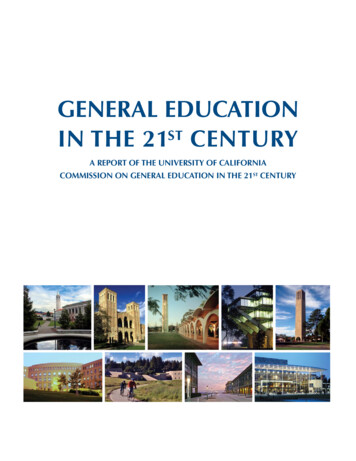
Transcription
GENERAL EDUCATIONIN THE 21ST CENTURYA Report of the University of CaliforniaCommission on General Education in the 21st Century
GENERAL EDUCATIONIN THE 21 ST CENTURYA Report of the University of CaliforniaCommission on General Education in the 21st CenturyApril 2007Center for Studies in Higher EducationUniversity of California, Berkeley CSHE 2007 All Rights Reservedhttp://cshe.berkeley.edu/research/gec/
This report was made possible by funding fromCarnegie Corporation of New York and the William and Flora Hewlett Foundation.Photo Credits: Courtesy of University of California, Berkeley; University of California, Los Angeles; University ofCalifornia, Riverside; University of California, San Diego; Brenda Reheem/University of California, Santa Barbara;University of California, Irvine; Jim Mackenzie/University of California Santa Cruz; 2006 Christopher Viney, Ph.D./University of California, Merced; Debbie Aldridge/University of California, DavisGENERAL EDUCATION IN THE 21ST CENTURYii
TABLE OF CONTENTSMembers of the Commission . .vPreface . viExecutive Summary and Recommendations . ixPrologue . xiiiSECTION 1:Justification . 1Why Now?. 1Why Focus on Public Institutions?. 3Why California?. 4SECTION 2:Clearing the Underbrush: Some Definitional and Historical Reflections . 6History. 8SECTION 3:Structure and Culture of the Academic Disciplines .11The Structure of Academic Departments.11Academic Culture.12Implications for General Education.13SECTION 4:Integrating General Education into the Fabric of the University .15SECTION 5:Curricular Innovation .20Requirements vs. Alternatives.21SECTION 6:Thinking Through the Civic Dimension .25Contemporary Interest in Civic Education.25Four Goals of Civic Education.27Civic Education: Conclusions.28SECTION 7:Transfer of Credits and Transfer Students .30Advanced Placement.30Transfer Students.31Special Issues.33SECTION 8:New Technologies and General Education .36Quality.36Reducing Costs.38Widening Access.38Conclusions on ICTs and General Education.39GENERAL EDUCATION IN THE 21ST CENTURYiii
SECTION 9:Encouraging a Culture that Supports General Education .41Faculty.41Graduate Students.43Non-Ladder and Part-Time Faculty.43Advising Staff.44Undergraduates.44Parents.45Chancellors and Presidents.45Alumni.45SECTION 10: Evaluating General Education Courses and Programs .46Recommendations of the Commission .48Endnotes .50Appendices .53APPENDIX A: Summary of Undergraduate General Education at University of California CampusesTable A-1: University of California general education requirements, by campus.53Table A-2: Recent campus-specific general education initiatives.55Table A-3: Freshman and sophomore seminar status at each UC campus.59APPENDIX B: Chief Undergraduate Education Officers Interviewed .60APPENDIX C: Comparison of General Education Reforms Among Institutions .61GENERAL EDUCATION IN THE 21ST CENTURYiv
MEMBERS OF THE COMMISSION ONGENERAL EDUCATION IN THE 21ST CENTURYMichael Schudson (co-chair)Professor, Communication and AdjunctProfessor, Sociology, UC San Diego, andProfessor, Graduate School of Journalism,Columbia UniversityNeil J. Smelser (co-chair)University Professor of Sociology Emeritus,UC BerkeleyJodi Anderson 2004-05 UC Student Regent, UC Los AngelesMark Appelbaum Professor, Psychology, and Associate ViceChancellor, Undergraduate Education,UC San DiegoThomas Carew Bren Professor, Department of Neurobiologyand Behavior, UC IrvinePedro Castillo Provost, Oakes College and Associate Professor,History, UC Santa CruzLynda Goff Professor, Biology, UC Santa CruzAndrew Grosovsky Professor, Cell Biology and Vice Provost forUndergraduate Education, UC RiversidePatricia J. Gumport Vice Provost for Graduate Education, Professor,Education, and Director, Stanford Institute forHigher Education Research, Stanford UniversityDiane Harley Senior Researcher, Center for Studies in HigherEducation, UC BerkeleyGregg Herken Professor, School of Social Sciences,Humanities, and Arts, UC MercedStanley Katz Professor, Woodrow Wilson School of PublicPolicy and Director, Center for Arts andCultural Policy Studies, Princeton UniversityM. Gregory Kendrick Professor, History and Director, FreshmanCluster Program, UC Los AngelesAnnie King Professor, Animal Science, UC DavisJoseph Kiskis Professor, Physics, UC DavisRaymond Knapp Professor, Musicology, UC Los AngelesWilliam Ladusaw Vice Provost & Dean of UndergraduateEducation and Professor, Linguistics,UC Santa CruzRoger McWilliams Professor, Physics & Astronomy, and Director,Campuswide Honors Program, UC IrvineYolanda Moses Professor, Vice Provost and Special Assistantto the Chancellor for Excellence and Diversity,UC RiversideCarolyn Porter Professor, English, UC BerkeleyJulie Reuben Professor, Graduate School of Education,Harvard UniversityBarbara Sawrey Senior Lecturer and Vice Chair, Chemistry andBiochemistry, UC San DiegoChand R. Viswanathan Distinguished Professor Emeritus, ElectricalEngineering, UC Los AngelesM. Stephen Weatherford Professor, Political Science, UC Santa BarbaraMuriel Zimmerman Sr. Lecturer Emerita, Writing,UC Santa BarbaraGENERAL EDUCATION IN THE 21ST CENTURY
PREFACEThe seeds of this report date from the years 1996-1999, the active yearsof the Penn Commission on Society, Culture and Community, whichwas convened by Judith Rodin, then-President of the University ofPennsylvania, and supported by the Atlantic Philanthropies. ThisCommission concerned itself with a wide range of cultural, moral, andpolitical issues connected to the quality of public discourse and political culture in ourdemocracy. The results of its work were published in 2003, in a volume entitled Discoursein America: Conversation and Community in the Twenty-First Century.1We, Michael Schudson and Neil Smelser, were both members of the Penn Commissionand contributors to its summary volume. We had known one another professionallybefore we were invited to join the Commission, but we grew close during its work,discussing between ourselves issues that arose, and developing our own views about theCommission and its work. We discovered how similar our thoughts were on many issuesof the day.In 2002, we began an email exchange, raising concerns about the state of generaleducation in the United States and discussing how we might in some way join forcesto contribute to and possibly influence the dialogue on that perennial topic. Over thenext months we refined our ideas and came to focus on a collective project that wouldlook at general education at the University of California (UC), where we had both madeour careers. Our hope was to create a commission—which later came to be known asthe Commission on General Education in the 21st Century—that would focus on theUC system, but would also raise questions and develop diagnoses and recommendationsthat might apply more generally.We subsequently brought these ideas to the Office of the President of the Universityof California, to the Systemwide Academic Senate, and to the Center for Studies inHigher Education (CSHE) on the Berkeley campus. The Office of the President andthe Academic Senate received our ideas very warmly and gave official expressions ofsupport. CSHE expressed a willingness to house the hypothetical project. In fact, wereceived every imaginable form of support—except financing—from the University ofCalifornia. The Office of the President provided funds for a small feasibility meeting,but a budget to support the work of a major commission could not be guaranteed. Thefeasibility group met on April 21, 2003, explored issues and prospects in-depth and, inthe end, voted its strong support for the envisioned commission.GENERAL EDUCATION IN THE 21ST CENTURYvi
P R E FA C EBuoyed by all of the institutional support and not overly discouraged by lack of resources,we turned to philanthropic foundations to seek the major funding. In the end, wereceived grants from Carnegie Corporation of New York and The William and FloraHewlett Foundation of Palo Alto. We give special thanks to Dan Fallon of the CarnegieCorporation and Mike Smith of the Hewlett Foundation for their personal interest andsupport. We are grateful for this generous private support which, among other things,allowed the Commission an important degree of autonomy. We repeatedly sought advicefrom the Office of the President, officers of individual campuses, and officials of theAcademic Senate, but nothing about their advice was mandatory, since we were assuredsupport from other sources. We have thus proceeded independently throughout theentire course of our work.With institutional support and financial resources in hand, we turned to the formidabletask of constituting the Commission. This called for extensive consultation withuniversity-wide officials, campus administrators and faculty members, and officers ofthe Academic Senate. We included at least one representative from every UC campus,and added several representatives from non-UC private institutions. We strove fordisciplinary diversity as well as a mix of administrative and faculty personnel. We weregratified that almost all of the individuals initially invited to join the Commission onGeneral Education in the 21st Century agreed to serve and we regard this as a measure ofcommitment to the general education process on the University of California campuses.The members of the Commission are listed on page v.Our plans for the Commission’s work included five collective meetings, held between2004 and 2006. We were impressed with the intellectual vitality of each of these meetings.In the intervals between meetings, Diane Harley, Senior Researcher at the Center forStudies in Higher Education and a member of the Commission, coordinated research,dealt assignments to individual Commission members, directed the work and activitiesof a series of research assistants hired to work on behalf of the Commission, providededitorial oversight, and advised on the section covering new technologies. In the laterphases of the Commission’s work, we drafted materials to reflect the discussions andpoints of consensus generated in the meetings.As co-chairs, we would like to extend our thanks to the Commission members for theirtime, work, and insights, as well as to the university administrators and faculty memberswho offered strong and continuous support for the project. Chief among the latter wereJulius Zelmanowitz of the UC Office of the President; Gayle Binion of the AcademicAssembly; Karl Pister, Director of the Center for Studies of Higher Education (CSHE)from 2002-2004; and C. Judson King, Director of CSHE from 2004-present and Provostand Senior Vice President Emeritus, Academic Affairs, UC Office of the President. Weare grateful also to Carol Schneider, president of the American Association of Collegesand Universities, who shared her insights with Commission members at one of ourmeetings. We record our warmest thanks to Diane Harley, whose work was invaluable,GENERAL EDUCATION IN THE 21ST CENTURYvii
P R E FA C Eto several research and editorial assistants, including Deborah Apsel, Meghana Acharya,Cam Rutter, and Jonathan Henke, and to the administrative staff at CSHE and UCSan Diego. Our special thanks to Shannon Lawrence for managing the final editorialprocess.Michael SchudsonUniversity of California, San DiegoNeil J. SmelserUniversity of California, BerkeleyGENERAL EDUCATION IN THE 21ST CENTURYviii
EXECUTIVE SUMMARYAND RECOMMENDATIONSDiagnosis and understanding are prerequisites to sound recommen dation. With this in mind, this report analyzes the historical, institu tional, and cultural contexts of general education in the United States.We focus mainly (but not exclusively) on large public universities,with special reference to the California higher education system. Weprovide an overview of the history of U.S. higher education, with special attention to theemergence of major research institutions and the dominance in them of discipline-baseddepartments.Reform of general education must recognize the dominant academic culture in majorresearch institutions, which gives precedence to recognition for published research andother creative activity. This culture exercises a decisive influence on the incentives andmotivations of professional academics. Institutional, organizational, budgetary, andcultural contexts that we identify constrain the vigorous development of courses andprograms in general education. At the same time, only if we understand these featuresof higher education can we realistically identify opportunities for improving generaleducation in its university context.The first line of improvement the Commission envisions is administrative. Our startingpoint is the recent creation of positions of chief undergraduate education officer2 on theUniversity of California campuses in the past dozen years. The Commission regards thisas a very important and positive step toward improving campuses’ general educationprograms, although we have found a number of anomalies and weaknesses that charac terize these positions. Correspondingly, we recommend bringing these positions morecentrally into the administrative core of the university, giving high priority to theirinnovative potential and providing the incumbents with a renewable pool of funds todedicate to innovation and experimentation.With respect to curricular innovation in general education, the Commission readilyacknowledges the obstacles to innovation that reside in the structure and culture ofthe contemporary university, and in the orientations of most faculty, students, andadministrators. As one alternative to the dominant structure of general education—asprawl of cafeteria-style breadth requirements—we recommend the creation of structuredinterdisciplinary bundles of courses on timely intellectual and applied issues, madeavailable to students as discrete, named sets and identified as such on students’ transcripts.GENERAL EDUCATION IN THE 21ST CENTURYix
E X E C U T I V E S U M M A R Y A N D R E C O M M E N D AT I O N SWe also recommend extension of and improvements in freshman-sophomore seminars,capstone courses, problem-oriented courses offered by departments, and undergraduateinvolvement in research.The Commission highlights especially the need for renewed attention to civic educationas part of general education. We identify the new dimensions and problems of civiceducation in our rapidly changing world and the necessary components of good civiceducation in a democracy. In light of this, we advocate that campuses intensify the“civic experience” of students in their collegiate years, specifically in the form of studentactivities that combine civic engagement with research and reflective analysis.The Commission considers next the difficulty for universities in governing generaleducation requirements that students take outside the university from which they willgraduate. This includes two large and increasingly important phenomena: the taking of“advanced placement” (AP) courses in high school and the transfer of AP credits, and theprocess of transferring to the university after some experience in community college orstate-university settings. We recommend two strategies: first, that universities continueand extend working cooperatively with high schools and “feeder” colleges to coordinategeneral education expectations and offerings, and, second, that they extend and improvetheir general education offerings at the upper-division level.The Commission sees implications for general education in the spread of new technologiesin higher education. They can help improve educational quality, reduce costs, and widenaccess. At the same time, they are no panacea, and we identify a number of limits andexcesses that uncritical application of new technologies can generate.Improving general education requires not only initiating structural changes but sustaininga campus culture that supports general education. There is a need to publicize generaleducation’s value and, where possible, to reward the constituents and individuals involvedin it. With this in mind, the Commission addresses methods for informing, supporting,and encouraging faculty, graduate students, and temporary faculty, as well as advisingstaff, undergraduates, parents, chancellors and presidents, and alumni.Finally, while acknowledging the difficulties of effective educational evaluation, werecommend that campuses build in systematic machinery to evaluate general educationcourses and programs in their various phases of development and execution.GENERAL EDUCATION IN THE 21ST CENTURY
E X E C U T I V E S U M M A R Y A N D R E C O M M E N D AT I O N SThe following recommendations are directed to the University of California campuses inparticular, but have implications for public and private universities nationwide:1. Campuses should systematize their commitment to general education by re-castingand extending the role of chief undergraduate education officers. In particular, thesepositions should (a) be assured a conspicuous place, voice, and role in the centraladministration of campuses; (b) be given ample discretionary, renewable annual bud gets and other resources to promote courses and programs in general education; and(c) be protected, where appropriate, from routine administrative chores, in orderto enhance opportunities for initiative and innovation. (See Section 4: IntegratingGeneral Education into the Fabric of the University.)2. Campuses should give high priority to ensuring appropriate incentive structures thatenable faculty to participate in general education enterprises, thus easing a principalimpediment to faculty involvement in general education. (See Section 4: IntegratingGeneral Education into the Fabric of the University.)3. As one alternative to the “cafeteria approach” to general education—when studentschoose a set of courses from an unwieldy list of general education courses—campusesshould develop a discrete number of thematic, interdisciplinary bundles or sequencesof courses around substantive and timely topics. These packages could be considered asubstitute for discipline-based minors and could receive full academic recognition, soindicated on students’ transcripts. Students could select any given thematic packagevoluntarily, but once selected, all of its constituent parts would be required. (SeeSection 5: Curricular Innovation.)4. Campuses should give the highest priority to advancing the civic education andengagement of their undergraduates. In particular, they should expand and consoli date courses and programs that combine (a) students’ volunteer, service, or politicalwork; (b) instruction in the academic significance and importance of that work; and(c) individual or group-based student research related to their community involve ment. (See Section 6: Thinking through the Civic Dimension.)5. The University of California and its campuses should evaluate the implications ofadvanced placement credit and the academic work of transfer students for the generaleducation of its students. They should cooperate fully and equally with high schools,community colleges, and state universities, in order to safeguard the integrity andmaximize the quality and effectiveness of the general education of students whospend only part of their educational careers at the University. (See Section 7: Transferof Credits and Transfer Students.)GENERAL EDUCATION IN THE 21ST CENTURYxi
E X E C U T I V E S U M M A R Y A N D R E C O M M E N D AT I O N S6. Administrators and faculty should pursue applications of new information and com munication technologies to enhance teaching and learning, and potentially lowercosts and increase access to their institutions. At the same time, administrators shouldassure that educational quality is not inadvertently sacrificed in the process. (SeeSection 8: New Technologies and General Education.)7. Campus administrators and faculty should actively and continuously strive to educateall of their constituencies on the value, rationale, and goals of general education, andmake clear the opportunities for its pursuit on their campuses. Academic Affairs, aswell as Student Affairs, should engage in efforts to integrate transfer students into theuniversity, with specific course work designed for transfer students (including oneunit courses modeled on freshman seminars). (See Section 9: Encouraging a Culturethat Supports General Education.)8. To assure the quality of general education, campuses should (a) establish machineryin their Academic Senate divisions dedicated to initiating, monitoring, and reviewinggeneral education courses, programs, and experiments; and (b) require designers andteachers in general education to provide statements of the goals of their efforts,to specify means of implementing these goals, and subject their work to periodicinternal and external evaluation. (See Section 10: Evaluating General EducationCourses and Programs.)GENERAL EDUCATION IN THE 21ST CENTURYxii
PROLOGUEWriting in 1867, John Stuart Mill noted that education was “oneof the most inexhaustible of topics.”3 Several years later, hedescribed his age as one in which “education, and its improve ment, are the subject of more, if not profounder, study than atany former period of English history.”4 Mill was referring tothe never-ending debates about British working-class education—shrouded in issuesof religion and class as well as public concerns about the performance of middle classschools and the role of the historic public schools in the cultivation of the nation’s elite.In the first three-quarters of the century, these issues had consumed more pages in thereports of Parliamentary debates than any other subject save the Irish Question.The history of American education is similarly wordy. Educators, politicians, and thegeneral public have all placed heavy demands on public education. Why should this be?Through its history, American education has been asked to instill the values of republicanvirtue in the young people of a young nation, to assure literacy, to aid in the formationof a competent and civil working class as the country industrialized, to Americanizeimmigrants, to foster upward social mobility, and to contribute to great war efforts. Inrecent decades, education has been both blessed and burdened with new expectations:to provide the United States with tools to catch up with and surpass the Soviet Unionin space, to generate the skills needed for an economy with a burgeoning service sector,to carry much of the weight of affirmative action, and to assure international economiccompetitiveness. In effect, the institution has been asked to provide the answers for ahost of social problems that it alone cannot realistically solve.This fact alone would be sufficient to breed disappointment and repeated episodes ofwordy recrimination. If we add—particularly at the primary and secondary levels—thateducation and teachers have never been accorded the resources or prestige that such greatdemands would seem to justify, the stage is fully set for a history of public ambivalencetoward the educational system in the United States.We might extend this discouraging logic to the topic of general education in the nation’suniversities and colleges. Later we will note the multiple definitions—along with thecorrespondingly multiple demands—that have been assigned this function. We notealso the pulsating—but, on the whole, increasing—condemnations of universities andcolleges for failing in their general education missions. We have seen countless analyses,reports, and articles in academic journals that, in almost ritual repetition: (a) bemoanthe failures and identify the “crisis” of general education, (b) sing its praises in generalGENERAL EDUCATION IN THE 21ST CENTURYxiii
P R O LO G U Eterms, and (c) cal
Photo Credits: Courtesy of University of California, Berkeley; University of California, Los Angeles; University of California, Riverside; University of California, San Diego; Brenda Reheem/University of California, Santa Barbara; . School of Social Sciences, Humanities, and Arts, UC Merced Stan ley Katz Professor, Woodrow Wilson School of .


